Imagine you’re walking through an ordinary English churchyard, perhaps on a frosty winter day, plodding through the mist, stepping over clumps of white-glazed grass. Sheep huddle in the cold or nibble forlornly at the frozen ground; the graves are a typical selection of headstones, crosses and box tombs, moss and lichen covered; many inscriptions have worn away; some stones have sunk so far into the ground that only their curved or wavy tops are visible.
Then you trudge around the corner of the church building, look up, gasp, blink, look again. Your eyes are not tricking you – in front of you, there really does stand a 25-foot (7.6-metre) pyramid. It rises from the green land, against a background of bare trees; sheep bumble around it; moss patches its stones; its point tears at the mist, but – in this most English of scenes – it’s there: a pyramid, a miniaturisation of Ancient Egypt seemingly transported from the shores of the Nile and plonked down in a British churchyard.
And it’s not the only one. A number of such pyramid mausoleums are scattered across England – brooding in dark stone next to modest churches, crowning green hilltops or rising incongruously from the lush grass of aristocratic estates.
These pyramid tombs are magnets for bizarre legends – tales tell of glass strewn over their floors to repel the Devil, of occupants seated with bottles of wine to await the Resurrection. There are stories of the dead clutching playing cards in the hope of outwitting demons, of attempts to stop people dancing on ex-lover’s graves, of glimpses of tragic ghosts and of desperate schemes to keep family fortunes intact.
England’s pyramid tombs were the product of ‘Egyptomania’ – the passion for all things Ancient Egypt that gripped Europe and North America in the 18th and 19th centuries. Freemasons became fascinated with the Pyramids’ ‘sacred geometry’ and the esoteric secrets supposedly hidden in their designs. Neo-Egyptian buildings sprouted on European streets; Egyptian themes invaded literature, opera and art; and Egyptian motifs appeared on products as diverse as furniture, jewellery and dinner services.
And, as so much of Ancient Egyptian culture revolved around death, it’s not surprising that pyramid tombs began popping up in English churchyards and beyond. Though England boasts quite a range of wonderful pointy-topped mausoleums, I’ve attempted to compile a list of the ten best. So let’s go for a quick tour and see what we can make of England’s strange pyramid tombs.
Number 1: Mad Jack Fuller’s Pyramid in Brightling Churchyard, Sussex
The pyramid tomb described above is England’s most famous. It was erected to house the body of one ‘Mad Jack Fuller’ – the squire of the hamlet of Brightling, Sussex. The pyramid stands, dark and moody, in the corner of Brightling’s St Thomas a Beckett Churchyard, dominating the gravestones and even seeming to challenge the primacy of the church itself.
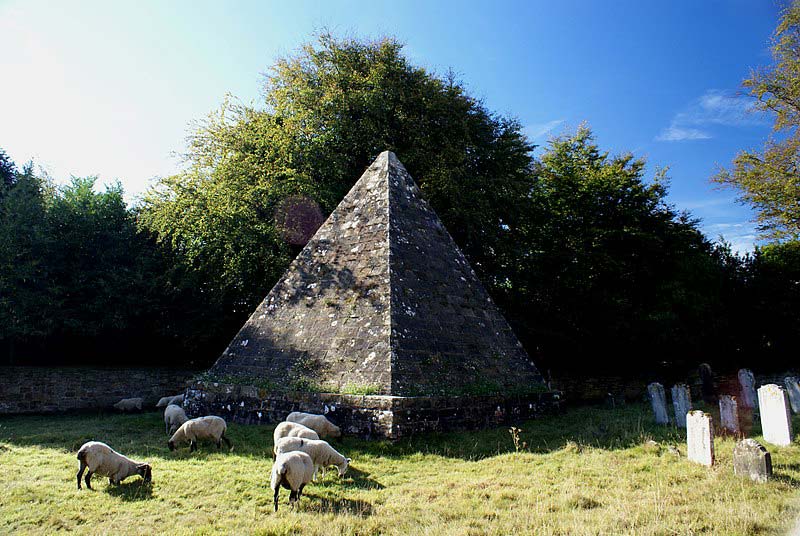
Mad Jack Fuller’s pyramid tomb in Brightling Churchyard, Sussex, England. (Photo: Plumbago)
Born in 1757, the famous eccentric John ‘Mad Jack’ Fuller served as a Member of Parliament for Southampton and Sussex. The Fuller family had made their fortune from iron foundries and Jack’s wealth was further boosted when he inherited his uncle’s Sussex estates and Jamaican slave plantations in 1777 at the age of just 20. Fantastically fat and a well-known drunk, Fuller was ejected from Parliament in 1810 by the Serjeant-at-arms after a passionate and alcohol-fuelled denunciation of the government. This incident resulted in public disgrace, effectively ended his political career and even led to Jack being threatened with imprisonment in the Tower of London.
Fuller used his substantial wealth to support scientific developments – including mentoring Michael Faraday, who conducted pioneering studies into electricity and magnetism. Jack also bought and commissioned a number of paintings from J.M.W Turner. But Mad Jack Fuller’s urge to be remembered went beyond sponsoring science and art – like the Egyptians, he wished to bequeath a legacy in stone. He constructed a number of follies on his estates – such as an obelisk, a mock Greek temple and a cone-shaped structure rumoured to have been built to win a bet – in addition to his pyramid mausoleum.
As the pharaohs had, Jack ordered that work should begin on his pyramid while he was still very much alive. The tomb was built between 1810 and 11, many years before his death in 1834. According to legend, Mad Jack Fuller was interred at the centre of his pyramid dressed for dinner, seated on an iron chair and wearing a top hat. On a table in front of him were a bottle of port and roast chicken, so that when the trumpet blast of the Resurrection came he wouldn’t be hungry or suffer thirst. Apparently, Fuller ordered that bits of glass should be scattered over the tomb’s floor – to prick the Devil’s cloven hooves and thereby discourage him from coming to claim Mad Jack’s soul.
Another story says that to get permission for his pyramid mausoleum – which takes up a quarter of the churchyard – Jack had to make serious efforts to persuade the vicar. Local folklore claims Jack even promised to move his pub – the Green Man – from opposite the church, as the tavern’s rowdiness was distressing for the devout. The pub was relocated to a converted barn and renamed The Fuller’s Arms.
When restoration work on the pyramid was done in 1982, the stories about Jack’s interment were found to be false. Mad Jack Fuller was buried rather prosaically beneath the floor of his mausoleum and there were no signs of roast chickens, bottles of port or broken glass. The tale about Jack having to move his pub is also untrue. The parish register states that – to be allowed to build his fantastical monument – Mad Jack Fuller was merely required to erect a new churchyard wall, along with an iron gate and two pillars.
Number Two: Nicholas Hawksmoor’s Pyramid in St Anne’s Churchyard, Limehouse, London
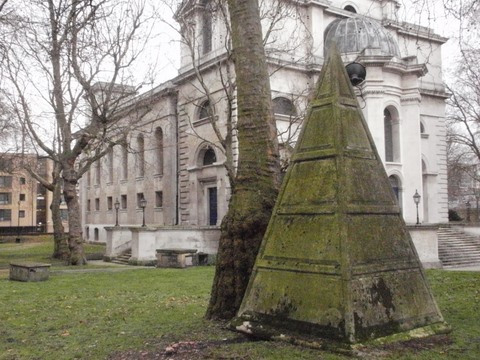
Nicholas Hawksmoor’s pyramid in St Anne’s Churchyard, Limehouse, London. (photo: cosmictigger)
A much smaller – but possibly more curious – pyramid stands in the churchyard of St Anne’s, Limehouse. Green and mossy, this slim structure reaches a height of 9 feet (2.74 metres) and bears the strange inscription ‘The Wisdom of Solomon’ in English and Hebrew.
No one knows the exact purpose of the pyramid. Some suggest it’s a grave marker; others suspect it was intended to decorate the church’s tower but – being surplus to the builders’ needs – was left in the churchyard. The architect of St Anne’s was Nicholas Hawksmoor (1661-1736). Known as ‘the Devil’s Architect’, Hawksmoor was a noted Freemason fond of peppering his buildings with ‘pagan’ symbols like obelisks and pyramids.
Perhaps only Hawksmoor knows why the pyramid is there and what its mysterious inscription refers to, though King Solomon – as builder of the Great Temple in Jerusalem – is revered by Freemasons. Hawksmoor apparently made plans for a full reconstruction of Solomon’s Temple, a monument which – like the Pyramids – was thought to express the universe’s secrets within its geometry. Another of the churches Hawksmoor designed, St Mary Woolnoth, is based on the Temple’s supposedly cubic shape. Hawksmoor’s St Anne’s pyramid is divided into five segments, which is reputedly another piece of Masonic symbolism.
Number Three: William MacKenzie’s Pyramid Mausoleum in St Andrew’s Churchyard, Liverpool
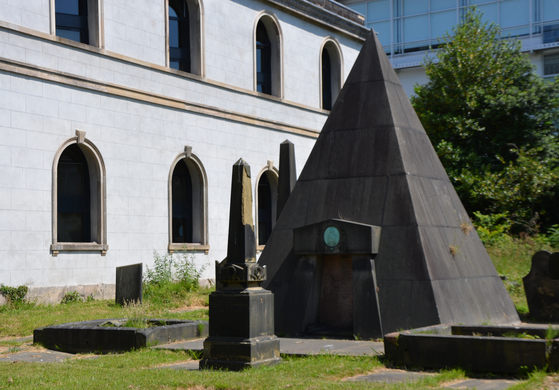
William Mackenzie’s pyramid tomb, in St Andrew’s Churchyard, Liverpool. (Photo: Atlas Obscura)
Another pyramid linked to ‘sinister’ mysteries can be found in St Andrew’s Presbyterian Churchyard, in Rodney Street, Liverpool. The pyramid is the tomb of William MacKenzie (1794-1851), a civil engineer and contractor who worked on some of Europe’s most important railways and canals. According to legend, MacKenzie was a gambler who had a wager with the Devil. To stop Satan claiming his soul, MacKenzie was interred sitting upright in his pyramid holding a winning hand of cards – as the Devil could never beat him, McKenzie hoped his soul would be safe.
The churchyard in Rodney Street is said to be haunted by MacKenzie’s ghost, a shadowy phantom in a top hat and cape that walks through the locked gates of the graveyard before entering the pyramid. A man who ‘saw’ the ghost in 1871 – and shortly afterwards died of fright – described MacKenzie’s face as being lit up with fire and his eyes as black and lifeless.
A slight variation on his legend says that one night MacKenzie played poker with a Mr Madison, who turned out to be the Devil. MacKenzie sold his soul in exchange for a winning streak and went on to request interment above ground in a bid to evade the Evil One’s clutches.
These stories, however, have little basis in fact. The pyramid tomb was commissioned by MacKenzie’s brother 17 years after his death. The inscription on the monument states ‘in the vault beneath lie the remains of William MacKenzie’, suggesting the pyramid’s occupant was interred neither above ground nor sitting up.
Another local legend has MacKenzie – in addition to his exploits on the railways and canals – operating as a body snatcher. He would – apparently – dig up fresh Liverpool corpses, pickle them in barrels and send them by ship to Scottish medical schools. There’s no evidence, however, to suggest that William MacKenzie led anything other than an upright and sober life, driven on by a ferocious Protestant work ethic.
Number Four: The Pyramid Tomb of Dr Francis Douce in Nether Wallop, Hampshire
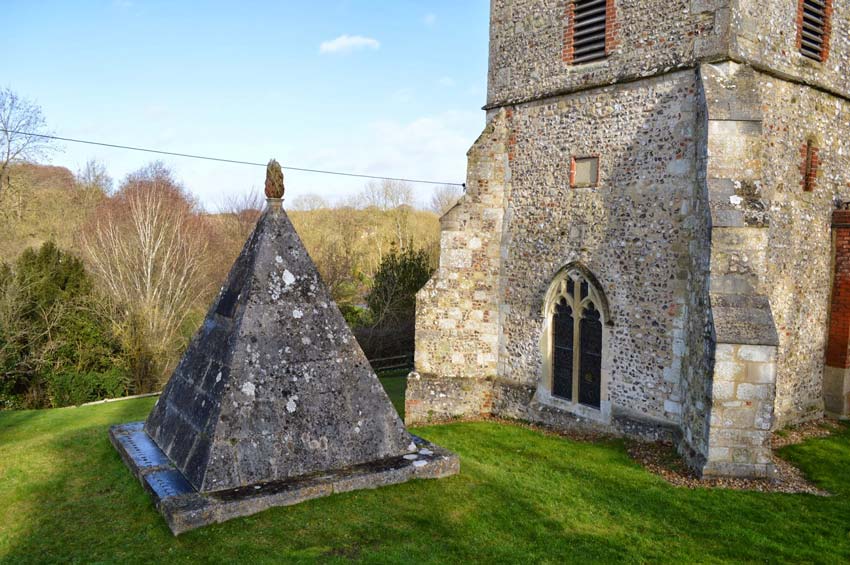
Dr Francis Douce’s pyramid tomb at Nether Wallop, Hampshire, England. (Photo: Random encounters with the unusual)
At Nether Wallop in Hampshire, a 15-foot (4.6-metre) pyramid can be seen in St Andrew’s Churchyard. Built for the physician Dr Francis Douce (1675-1760) in 1748, the pyramid boasts a flaming torch – a symbol of immortality – on its pinnacle. On the structure’s side are a coat-of-arms and an inscription proclaiming Douce ‘a Doctor of Physick’. In smooth sombre dark stone, this grade-II-listed tomb stands somewhat ominously in front of the church’s tower.
For the Ancient Egyptians, it was vital that the body was mummified and preserved and Douce seems to have had similar concerns. A member of the Company of Surgeons, he was obsessed with embalming, subscribing to a book in 1705 entitled The Art of Embalming Wherein Is Shown the Right of Burials and Funeral Ceremonies, especially that of Preserving Bodies after the Egyptian Method. This book laments the decay of unembalmed corpses – and stresses how easily they can be desecrated by animals and body snatchers – as well as recommending the pyramid as ‘the most durable structure’.
Douce’s will goes into exhaustive detail about how his pyramid should be maintained, and he left money to the parish – to support the elderly and educate poor children – on the condition his pyramid was well looked after. John Blake, the architect of Douce’s pyramid mausoleum, stated of the structure: ‘the area of the vault … is curiously paved with stone: the walls being very substantial … so it is a receptacle or lodging room fit for the remains of a prince … and the doctor’s bones may sleep undisturbed “till the Last Day”.’
Number Five: The Loudon Pyramid, St John the Baptist’s Churchyard, Pinner, Middlesex
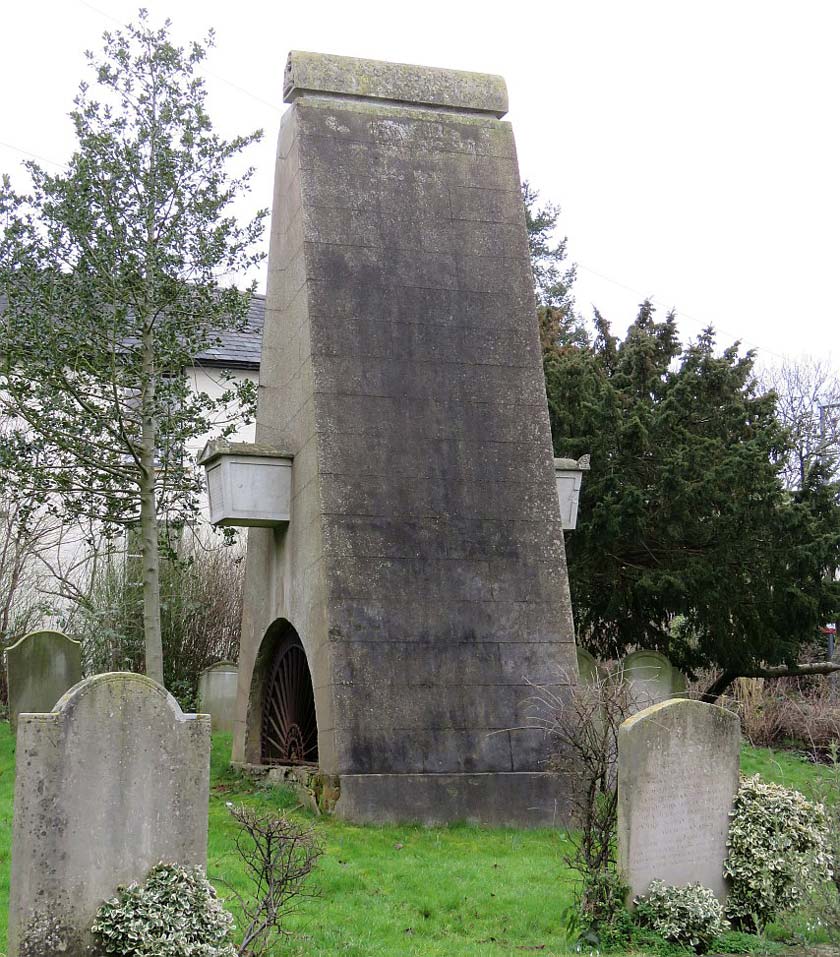
The Loudon Pyramid in Pinner, Middlesex, England. (Photo: speel.me.uk)
If you were wandering through St John the Baptist’s Churchyard in Pinner, you might be startled by the sight of a pyramid with a stone coffin thrust through its centre. Legend claims the architectural writer John Claudius Loudon designed this tomb as an ingenious response to a problem plaguing his family.
John was in danger of forfeiting his inheritance as a strange legal clause only permitted the Loudons to keep their fortune for as long as John’s parents ‘remained above ground’. By having the pyramid support his parents’ coffin, John made sure they did indeed stay ‘above ground’ and so their fortune could be passed down to him.
Number Six: Pyramid in St Thomas’s Churchyard, Box, Wiltshire
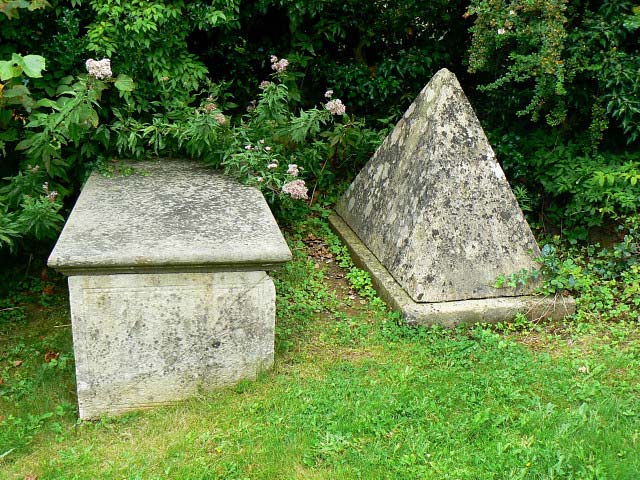
A small pyramid on a grave in Box, Wiltshire, England. (Photo: Brian Robert Marshall)
A small pyramid-like structure stands on a grave in St Thomas’s Churchyard, in the village of Box, Wiltshire. The tomb bears no legible inscription and no records have been found that can account for its unusual shape. A local legend, however, maintains that the widow of the tomb’s occupant planned to dance on his grave to celebrate his passing. To prevent this indignity, his friends erected a small pyramid over his resting place.
Number Seven: ‘His and Hers’ Pyramids in Staverton, Gloucestershire
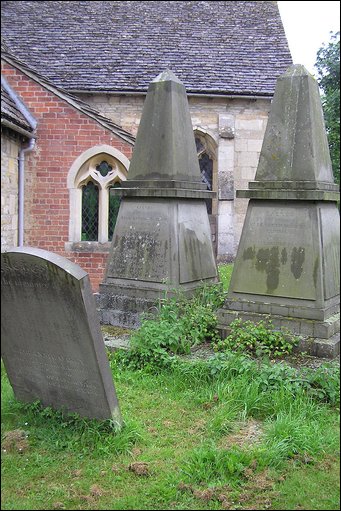
The ‘his and hers’ pyramid tombs of the St Clairs, Staverton, Gloucestershire, England. (Photo: BBC)
In Staverton Churchyard, identical ‘his and hers’ pyramids commemorate David St Clair and his wife Elizabeth. Built upon Elizabeth’s death in 1855, the monuments proclaim the St Clairs ‘an ancient family’. For centuries, the St Clairs had been associated with the Freemasons, so this connection may well have influenced the unusual design of David and Elizabeth’s tombs.
Number Eight: Pyramid to a Horse on Farley Mount, Hampshire
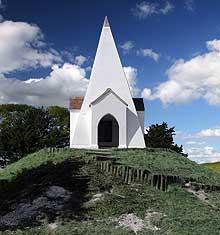
This attractive white pyramid on Farley Mount commemorates a horse. (Photo: gothisplace)
Not all English pyramids commemorate humans. On Farley Mount, Hampshire, an impressive white pyramid honours a horse that – a plaque tells us – in ‘September 1733 leaped into a chalk pit twenty-five feet deep a fox-hunting with his master on his back.’ Both horse and master survived and the horse went on to win ‘the hunter’s plate on Worthy Downs and was rode by his owner.’
That owner, Sir Paulet St John, was so grateful to his horse for both saving his life and winning him – no doubt – a substantial amount of money that he erected the pyramid. The Egyptians sometimes mummified animals, and creatures as diverse as cats and fish have been found in their tombs. Could the Farley Mount pyramid be a similar attempt to conserve the memory of a beloved non-human companion?
In Leckhampton, Gloucestershire, a more basic memorial – a rough pyramid of large stones – marks the grave of The Continental, a favourite horse that died in 1902.
Number Nine: Memorial to ‘The World’s Oldest Man’, in Bolton-on-Swale, Yorkshire
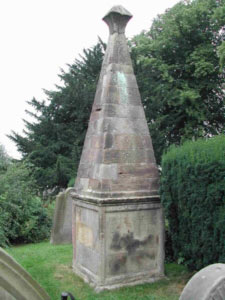
A pyramid-shaped memorial to Henry Jenkins, in Bolton-on-Swale. (Photo: Tom Courtney)
In the churchyard of Bolton-on-Swale, Yorkshire, there stands a pyramid-shaped memorial to Henry Jenkins, a local man said to have lived to the age of 169. Even after he reached 100, Henry apparently fathered a child and swam regularly across the Swale, England’s fastest-flowing river.
Supposedly born in 1501, Henry claimed to have helped transport arrows to the Battle of Flodden Field (1513) and to have met the Abbot of Fountains Abbey (closed by Henry VIII in 1539) while working as a butler. Henry Jenkins died in 1670 and his pyramid memorial was erected in 1743. In Ancient Egypt, after 30 years on the throne – and every three or four years thereafter – the Pharaoh would take part in the Heb Sed festival, during which he would run around a ritual course four times to prove his continued vitality and fitness to rule. A pyramid is perhaps, therefore, a suitable monument to Henry Jenkins’s long life and incredible vigour.
Number Ten: The Earl of Buckingham’s Pyramid Mausoleum, Blickling Hall, Norfolk
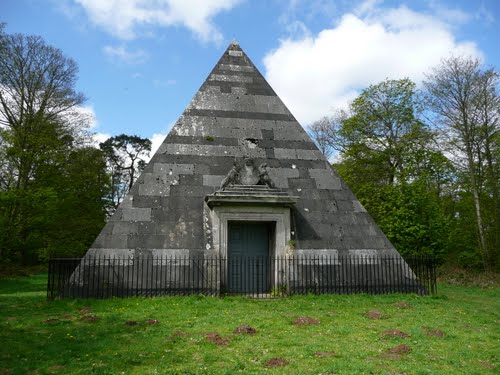
The Earl of Buckingham’s pyramid, Blickling Hall, Norfolk, England. (Photo: geoview)
If you wander through the very English gardens of Blickling Hall in Norfolk, you’ll come across a pyramid tomb. An incredible 45 feet (13.7 metres) high, the pyramid contains the bodies of the Second Earl of Buckingham (died 1793) and his two wives. The Earl’s arms are prominently displayed, over an enormous portico. Inside, the pyramid mausoleum boasts a marble pavement and three stone sarcophagi, which were brought by water from London.
The pyramid was commissioned by the Earl’s daughter Caroline – who inherited his estates – and her husband. This display of mortuary grandeur set the couple back by the equivalent of £200,000 in today’s money, a cost met in part by Caroline selling her jewellery. The pyramids of Ancient Egypt were intended as impressively-sized legacies to the pharaohs’ importance that would endure down the ages. Perhaps Caroline’s outlay of cash was made in the hope of similar results for the Earl.
Honourable Mentions
A number of impressive pyramid tombs are scattered around England and – though there isn’t space to describe them all here – I want to mention a few pointy-topped memorials that didn’t quite make the top ten.
In Sharow, Yorkshire, can be found the pyramid of Charles Piazzi Smyth (1819-1900). A professor of astronomy, Smyth became obsessed with Ancient Egypt. Convinced the Great Pyramid held the secrets of the universe, he travelled to Egypt, where he studied its every stone and calculated its every angle. He took the first photos of its interior, using coils of magnesium wire to produce a bright light. Out of all this came several books, most notably Our Inheritance in the Great Pyramid. Smyth’s ideas provoked both praise and ridicule though towards the end of his life the mockery outweighed the plaudits. Perhaps as a compensation, Smyth is buried under his own pyramid, with its inscription declaring him ‘a Bright Star in the Firmament of Ardent Explorers of the Works of their Creator.’
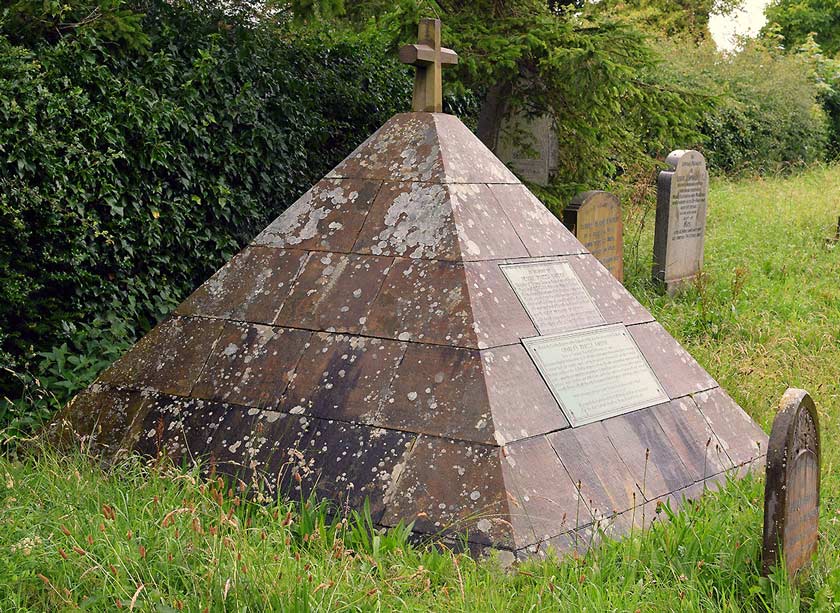
The pyramid tomb of Charles Piazzi Smyth in Sharow, Yorkshire, England. (Photo: teessidepsychogeography)
Near Ipsden, Oxfordshire, a dilapidated pyramid lies on the edge of a wood. It marks the place where in 1827 Anna Maria Reade glimpsed the ghost of her son John, who was away working in India. Anna Maria was so convinced her son was dead that she organised a memorial service for him at Ipsden Church. News of John’s passing came the day after the service had taken place.
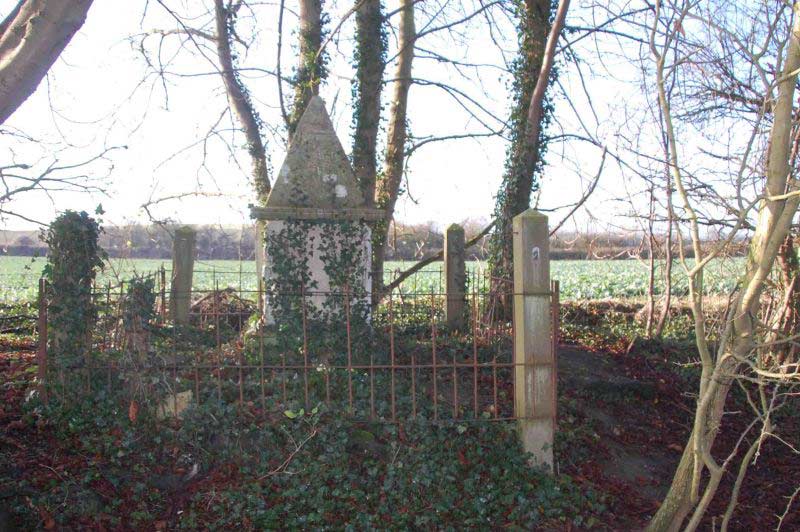
Pyramid-shaped memorial to John Thurlow Reade, near Ipsden, Oxfordshire, England. (Photo: Britishlistedbuildings)
In the churchyard of Attleborough, Norfolk, is the pyramid of one William Henry Brooke, who died in 1929. Brooke, a solicitor, left a will which – with lawyer-like precision – gave exact instructions for how his tomb should be constructed. The pyramid is six feet (1.82 metres) high and built of white limestone. The Ancient Egyptian pyramids were originally clad in white limestone too, so they would shimmer in homage to the sun.
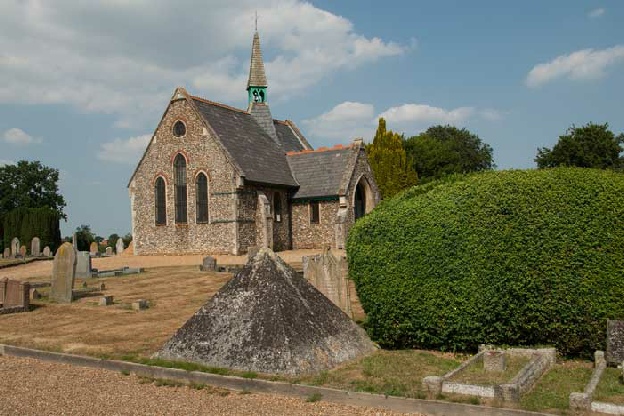
Lawyer Brooke’s pyramid tomb in Attleborough, Norfolk. (Photo: curiousbritain)
Pyramid tombs seem especially common in the churchyards of Gloucestershire. A three-sided pyramid – in honour of the Holy Trinity – serves as a memorial to the Dunn Family at Woodchester. Handsome pyramids also mark the graves of textile titan Joseph Ellis at Stonehouse, the Dyer family at Prestbury, and the famous stonemason (possibly also a Freemason) John Bryan at Painswick.
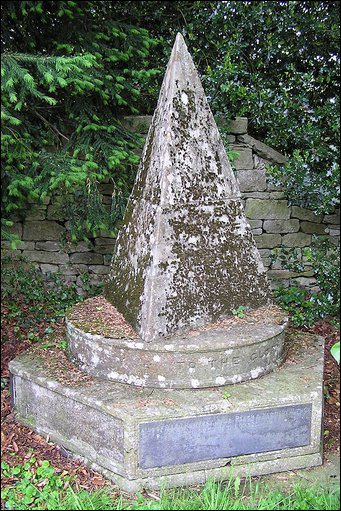
The Dunn’s pyramid, in Woodchester, Gloucestershire, is three-sided, in homage to the Holy Trinity. (Photo: BBC)
What Might Have Inspired the Georgians and Victorians to Build England’s Pyramid Tombs?
The English pyramid tombs described above were largely the result of Egyptomania. This craze intensified as the 18th and 19th centuries progressed, with explorers and colonialists bringing back more accounts of Egypt and scholars and archaeologists uncovering more of its ancient secrets.
Ancient Egypt especially chimed with the growing Victorian obsession with death. We can see this in the Egyptian Avenue in the grand Victorian necropolis of Highgate Cemetery and in the high society parties during which ‘Ancient Egyptian mummies’ – some genuine, some fake – would be ‘unwrapped’ before a fascinated audience. In one particularly bizarre case, the body of a respectable Manchester heiress even ended up being mummified and displayed in a local museum alongside mummies from Peru and Egypt. It’s not surprising that Egyptomania inspired a number of English people to have pyramids – albeit miniature ones – constructed for their own tombs.
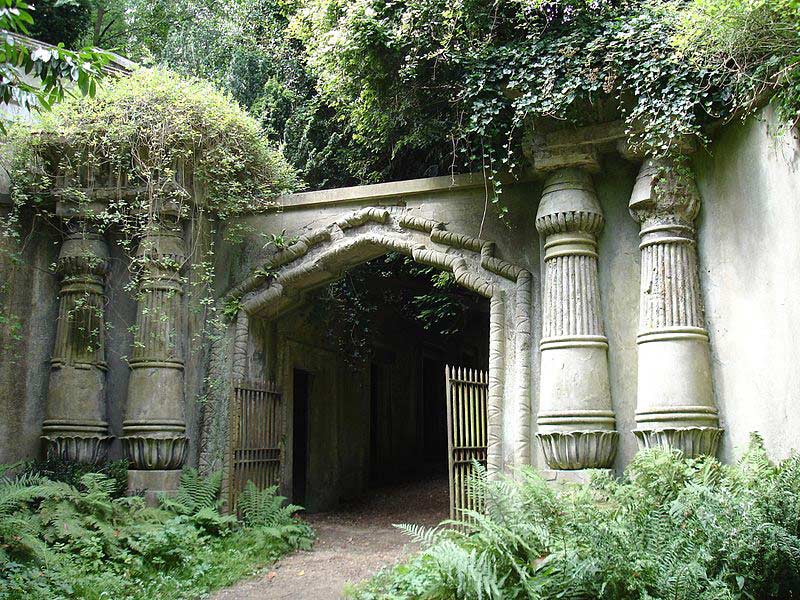
The gate of the Egyptian Avenue in Highgate Cemetery, London. (Photo: John Armagh)
But perhaps the pyramid – though more popular in some eras than others – is an archetype that prevails through the ages, an archetype that represents common human hopes, desires and fears. It seems to me that the whole concept of the pyramid – and the mummification rituals linked to it – is centred on the idea of having things preserved.
This could be people wishing – whether Egyptian Pharaohs or English aristocrats – to have their grandeur embodied by a striking stone monument that will last through the centuries. It could also be people wishing to conserve their wealth, whether we’re talking about an inheritance in Pinner or the treasures discovered in Tutankhamun’s tomb in the Valley of the Kings, which included ‘strange animals, statues and gold – everywhere the glint of gold.’
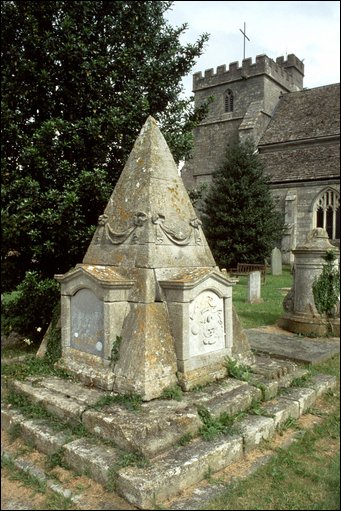
The pyramid tomb of Joseph Ellis in Stonehouse, Gloucestershire. (Photo: BBC)
There is also, of course, the obsession with resurrection and the fate of the soul in the afterlife. There’s speculation that early stepped pyramids were seen as staircases that allowed the Pharaoh’s soul to ascend to heaven. In addition, pyramids may have been viewed as devices designed to ‘shoot’ the Pharaoh’s spirit into the dark section of the night sky. This area – around which the stars appear to revolve – might have been seen as the gateway to the realm of the gods. The legends attached to England’s pyramid tombs also show a desire for resurrection and concerns over the safeguarding of the soul.
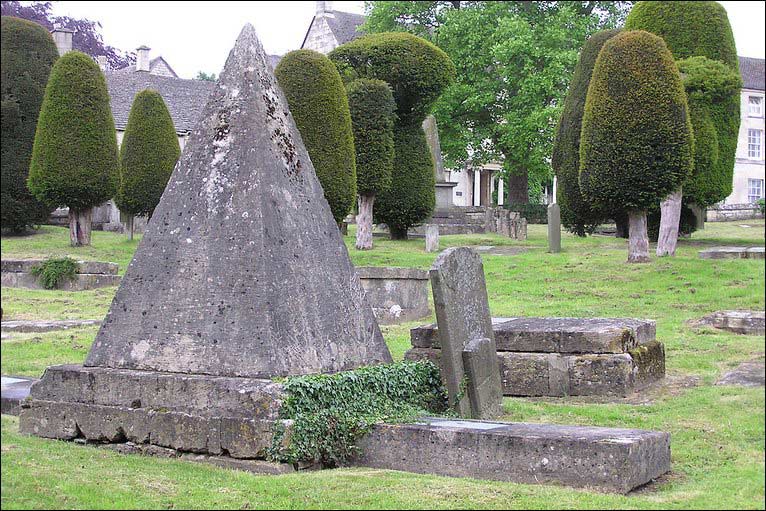
The pyramid of John Bryan in Painswick, Gloucestershire. (Photo: BBC)
The 18th and 19th centuries were times of growing individualism and this was apparent in the culture of death. The idea that an individual could ever cease to exist was becoming difficult to deal with. This led to a greater focus on the fate of the corpse. As with Doctor Douce, there was a fixation on the embalming and coffining of bodies, as well as a growth in the number of individualistic tombs. It’s easy to see why the mummified bodies, pyramids and stone sarcophagi of the Egyptians resonated so significantly with the Georgians and Victorians.
All this has left some very special monuments in our churchyards though whether these English pyramid tombs will ever enjoy the longevity or fame of the pharaohs’ mausoleums remains to be seen.
(This article’s main image – showing Mad Jack Fuller’s pyramid mausoleum – is courtesy of Urban Ghosts.)

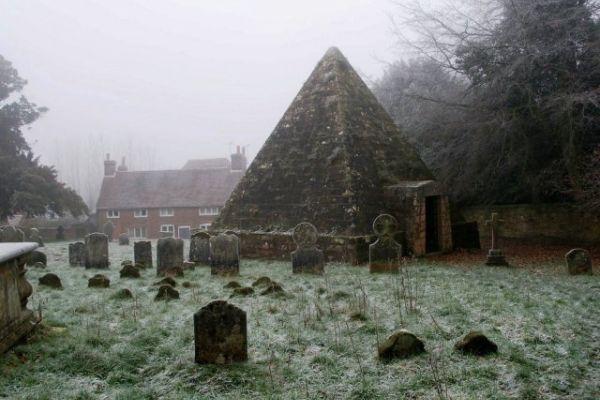
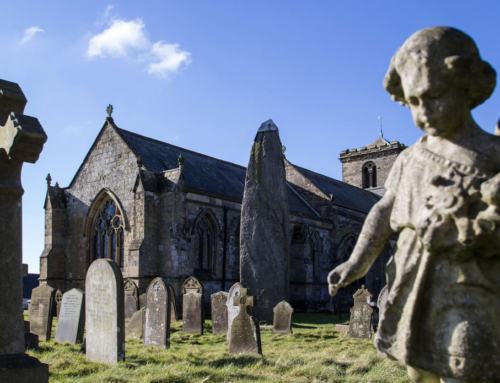
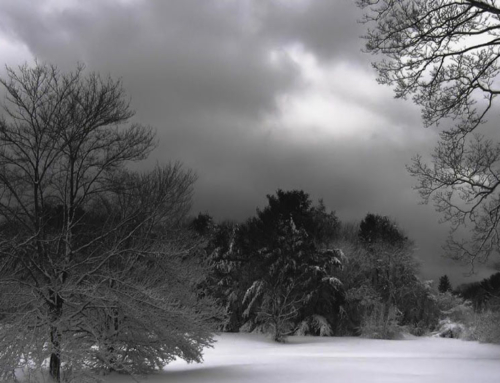
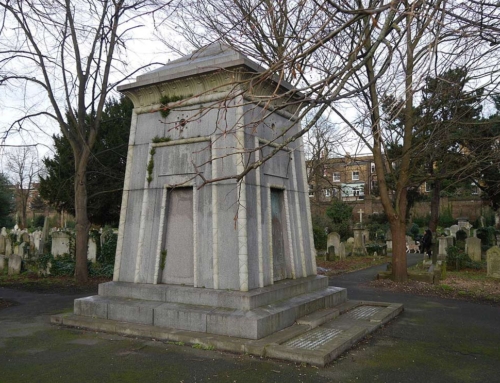
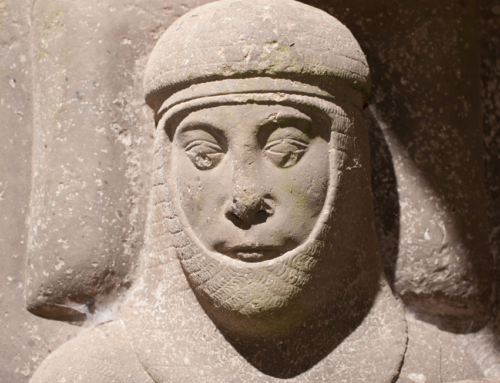
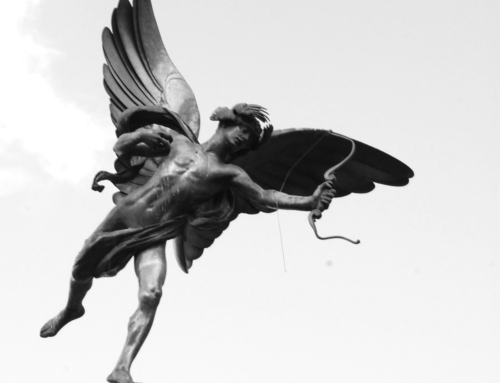
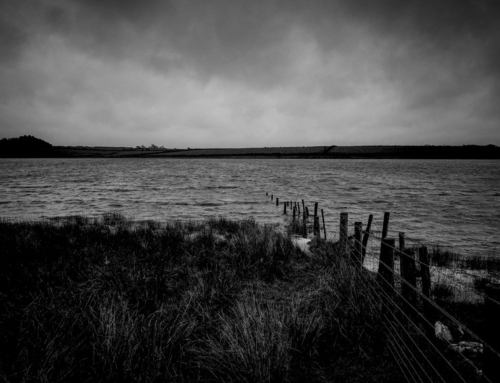
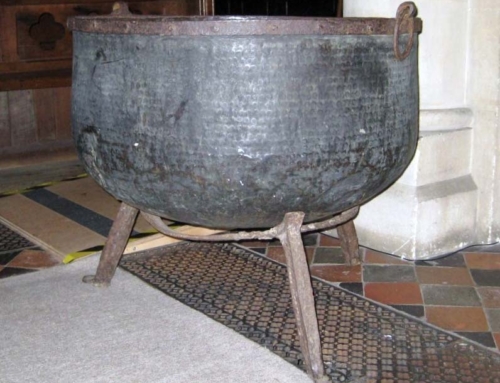
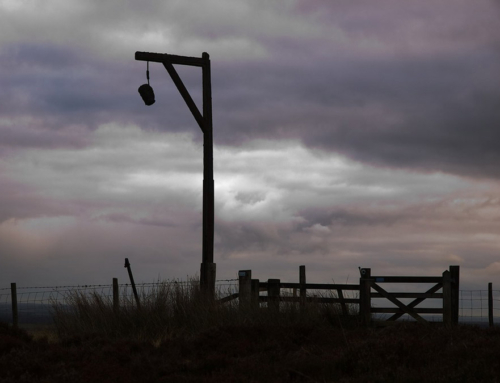
There is also a pyramid shaped tomb in Spetisbury Dorset for the rector Thomas Rackett and his wife Dorothea. He was rector if St Johns for about 60 years before his death in the mid 19th century. I’ve tried to find why he’s been buried under a pyramid but so far your explanation of Egyptomania seems most likely. He was interested in all things antiquary so it’s possible ancient Egypt was one of them.
Hi Glyn, his pyramid tomb is a tetrahedron, meaning a three-sided pyramid, so it may have been meant as a symbol of the Holy Trinity. But it’s also almost certainly true that the pyramid would have been inspired by Rackett’s antiquarian interests. And, yes, it’s probable that an antiquarian gent of that period would have been influenced by the Egyptomania prevalent in England at that time.
In St Ives Cornwall there is a pyramid built by John Knoll he wished to be buried there but was interred in London. Every so many years – I think 7, 12 local girls and 2 widows dance through St Ives and round his monument was surprised not in list
Hi Gill, I had vaguely heard of this legend. But there are so many strange and fascinating pyramid tombs in England that it would have been impossible to include them all in the post.
Did someone steal a pyramid….I wonder!!
Hi David, I wonder if Glastonbury Tor is a big non man made pyramid?
Hi Joan, the Tor is a natural feature, but there is a lot of folkore and mythology associated with it. Some claim it was King Arthur’s Isle of Avalon. Others view it as the entrance to the Welsh otherworld, associating it with Gywn Ap Nudd, seen as lord of the otherworld and, later, as king of the fairies.
You forgot the pyramid on top of one Canada tower
There are many pyramids in Britain – I couldn’t include them all! And – at least as far as I know! – that pyramid isn’t a tomb.